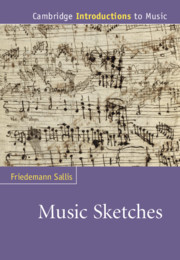Book contents
- Frontmatter
- dedication
- Contents
- List of figures
- List of music examples
- List of tables
- Preface
- Chapter 1 Introduction
- Chapter 2 Sketch studies past and present
- Chapter 3 Tracking down evidence of the creative process
- Chapter 4 The physical objects of the compositional process
- Chapter 5 Studying loose leaves
- Chapter 6 Sketchbooks
- Chapter 7 Transcription and facsimile reproduction
- Chapter 8 Sketches and the critical edition of music
- Chapter 9 Dangerous liaisons: the evolving relationship between sketch studies and analysis
- Chapter 10 Musical palimpsests and authorship
- Appendix: Beethoven sketchbooks published between 1913 and 2013
- Notes
- Glossary
- Bibliography
- Index
Chapter 1 - Introduction
Published online by Cambridge University Press: 05 February 2015
- Frontmatter
- dedication
- Contents
- List of figures
- List of music examples
- List of tables
- Preface
- Chapter 1 Introduction
- Chapter 2 Sketch studies past and present
- Chapter 3 Tracking down evidence of the creative process
- Chapter 4 The physical objects of the compositional process
- Chapter 5 Studying loose leaves
- Chapter 6 Sketchbooks
- Chapter 7 Transcription and facsimile reproduction
- Chapter 8 Sketches and the critical edition of music
- Chapter 9 Dangerous liaisons: the evolving relationship between sketch studies and analysis
- Chapter 10 Musical palimpsests and authorship
- Appendix: Beethoven sketchbooks published between 1913 and 2013
- Notes
- Glossary
- Bibliography
- Index
Summary
To observe notation through successive eras of written music enables one to seize the characteristics of the sound world that musicians chose to privilege, given the mutations of aesthetic thought.
Jean-Yves Bosseur, Du Son au SigneObjects of study, scope and the ‘poietic fallacy’
Musical sketches are objects that composers produce as they create their work. The study of this material has traditionally meant the careful examination of paper documents. This practice arose in the nineteenth century and was closely associated with (but not limited to) the reception and exegesis of Ludwig van Beethoven’s work, which has led some scholars to assume that Beethoven’s surviving sketches and drafts constitute the point of reference for sketch studies per se. Indeed, the very terms we use (sketch, draft, fair copy, derived from Skizze, Entwurf, Reinschrift and their equivalents in other languages) acquired musical coinage in the nineteenth century as collectors, critics and scholars attempted to make sense of Beethoven’s manuscripts. While the terminology, criteria and methods developed to classify and examine this corpus were foundational, they are not universally valid. Consider the composition of electroacoustic or digital music and the resulting source material. Examining Agostino Di Scipio’s early work (1987–2000) requires scholars to extract information about his compositional technique from a wide variety of sources, including magnetic tape, floppy discs and digital hard drives, as well as dealing with manuscript material containing notes, diagrams, drawings, etc. Work on Beethoven’s legacy may also prove to be of less than central importance for the study of music composed before the French Revolution. New terms and different criteria may have to be developed in order to properly examine creative processes in which borrowing and pastiche were ubiquitous and in which the production of music was often collaborative, involving composers, copyists and performers. The single author paradigm, which continues to dominate sketch studies today, would have seemed strange in an era that had little sense of copyright.
- Type
- Chapter
- Information
- Music Sketches , pp. 1 - 14Publisher: Cambridge University PressPrint publication year: 2015

